Joel Raupe
Lunar PioneerNot enough is being written about the 40th anniversary of
Apollo 12, and that surprises me a little. I know it shouldn't. After all, there are at least a hundred million Americans alive today for whom last July's Fortieth Anniversary of Apollo 11 must have seemed similar to what I experienced during that same anniversary in 1967 of Charles Lindbergh's
solo flight across the Atlantic.
It's a good thing we have those tapes reproducing the improperly synched and smeared black and while television images of Neil Armstrong's first steps. It's sweeter still that Mark Robinson and his LROC team, who so skillfully operate the Narrow Angle Camera on the Lunar Reconnaissance Orbiter (LRO) released detailed photographic surveys of the Apollo landing sites, showing those first steps still so well-preserved on lunar surface.
Otherwise someone might come up with some "conspiracy theory," insisting the whole thing was taped on a sound stage, perhaps at Area 51 or something.
If that had been the case I would have to compare such theories with the opinions expressed by my Grandfather, a half-Plains Indian, cowboy and shell-shocked veteran of World War I, who would never quite grasp the concept of Earth orbit, let alone traveling to the Moon.
I'm going to have to ask you to imagine experiencing this thing through the eyes of a ten-year-old, a certifiable space fanatic who was forced to sit in the backseat to impatiently listen to my Grandfather and his brothers as they rationalized this news of Americans on the Moon, somehow both impossible and a national triumph.
My Grandfather theorized from behind the wheel of his dusty Ford, windows rolled down as he tooled around the Central Texas countryside that, while it was clearly impossible for humans to actually be walking on the Moon, it was "still a good thing, what they're doing."
"What they done," he concluded, "was land over there in Japan, in them bum craters, which was a good thing, since no one had been there since they dropped them bums."
My father, a decade younger than I am today, had to insist I keep my silence, and I did, reluctantly, occasionally dodging my grandfather's chewing tobacco, little wet payloads launched suborbitally out the driver's side window.
He meant, of course, that "the government, up in Washington" had, instead, landed military personnel in spacesuits at the sites of the first nuclear "bum" explosions: Alamogordo, Hiroshima, Nagasaki and Bikini Atoll.
"Son," he would say, rolling his eyes each time that this interesting, if chatty, ten-year-old grandson of his tried hard to explain basic Newtonian Mechanics, a genial grin on his face, chiding me through the rear-view mirror, "what keeps it up there?"
And I've patiently ignored, without any contempt prior to investigation, any and all of the best conspiracy theories about the Apollo Moon landings ever since.
Allow me also to forego sharing too much detail of Apollo 12 that you can find on your own, today, using any respectable search engine. In the Apollo Era, fanatic followers of NASA had to wait usually about six months to see a selection of the best photographs from each of those missions, as presented in National Geographic. Not until the middle of the 1990's was I aware that higher resolutions of the still photography from those missions was remotely possible.
Apollo 12 was a historic demonstration of what still remains close to the cutting edge in orbital mechanics and engineering. The mission was designed originally as a stop-gap and back-up should Apollo 11 fail, and became instead the first true precision landing on the Moon.
A glance at the contemporary pictures of the landing site, the landing site of Surveyor 3, shows a puzzling plain featuring the chaotic layers of crater saturation in the vast equatorial Oceanus Procellarum, and it still has me shaking my head in admiration for the sheer talent that made this landing happen forty years ago.
It will take us years to catch up with where we dared reach. (Compare this situation with the state of aviation forty years after "Lucky" Lindy's flew the Atlantic.)
Yes, I'm still awed, wondering how mission planners knew so precisely which crater Surveyor 3 was sitting, the very crater, where it would just be beginning it's 35th lunar sunrise, 944 Earth-days after its robotic landing (and then a re-landing) in April 1967.
Conrad and Bean, frankly, were ecstatic when the lunar module Intrepid tipped forward through Terminal Descent and they instantly spied the "Snowman" cluster of craters where Surveyor 3 waited patiently.
Cheerful Commander Charles "Pete" Conrad, Jr., USN (1930 - 1999) became the third person to walk on the Moon, November 19, 1969, just four months after Armstrong & Aldrin the previous July.
Apollo 11 was a hard act to follow, but if anyone was best suited to provide some needed entertainment value, where Armstrong had provided needed steely precision, it was Pete Conrad.
Short, energetic, it's difficult to find any picture of the man without his trademark, gap-tooth smile. He and Al Bean were a friendly team, a notable contrast with the cautious crew Apollo 11.
Again, put yourself in my ten-year-old shoes, that November.
I had followed (and still follow) each and every mission, manned or unmanned. And on that "School Night," I strained to listen to the live communications, through the now-classic ridiculous jabbering of television network commentators and readers, even waiting through commercials.
It was my junk, since Telstar, at least.
Still, I didn't miss much that night, though the more easily distracted were already drifting away from the much larger Cloud of Witness the previous July.
So I was sat glued to the television, with my collection of glued-together models, of a Saturn V, an Apollo CSM-LM combo, a separate Lunar Module and my Rand McNally Moon map. And I listened to the faceless voices, so far away, to Conrad & Bean excitedly relaying their Comm through another daring descent.
At some point, I looked around the living room and realized I was the only one awake in the house. But my Mother (who quietly shared my enthusiasm for space travel, who had turned me on to Star Trek) fought sleep and finally did slip into the room, perhaps as worried for me missing sleep than for Pete Conrad and Al Bean.
Their landing passed, and I fell asleep, knowing it would be many hours before they would disembark.
I was waiting for the television, and, for the first time, a color camera.
My Mother nudged me back awake, admonishing me to back away from the new color television around daybreak. As I rubbed my eyes, Conrad was suddenly visible in our living room coming down the ladder, upside down at first, soon rectified by Houston.
It looked a lot like Apollo 11, only this time, the scene was definitely "in color."
Color television was still "new," or "newly cheaper," finally reaching a fifty percent household saturation, essentially the same technology first publically demonstrated at the 1939 New York Worlds Fair.
The rest of the household began to gather, and my stunned father, already dressed and primed for work, changed his mind and decided to go in late, instead. He wasn't as above "all that" as he thought.
Today, you can watch it all on the Internet, if you carefully dodge the conspiracy uploads, and witness every moment of what we saw Live From The Moon during the following twenty minutes or so. The highlights of that brief, very promising but tragically brief broadcast is discussed on Wikipedia:
"When Conrad, who was somewhat shorter than Neil Armstrong, stepped onto the lunar surface, his first words were "Whoopie! Man, that may have been a small one for Neil, but that's a long one for me."[4] This was not an off-the-cuff remark: Conrad had made a $500 bet with reporter Oriana Fallaci he would say these words, after she had queried whether NASA had instructed Neil Armstrong what to say as he stepped onto the Moon. Conrad later said he was never able to collect the money.[5][6]
"To improve the quality of television pictures from the Moon, a color camera was carried on Apollo 12 (unlike the monochrome camera that was used on Apollo 11). Unfortunately, when Bean carried the camera to the place near the lunar module where it was to be set up, he inadvertently pointed it directly into the Sun, destroying the vidicon tube. Television coverage of this mission was thus terminated almost immediately."
That single broadcast would be the first and only color television coverage of a Moon landing until Apollo 14, in 1971. The hiatus, of course, was due to the Apollo 13 abort the following April.
Even then, much of the Apollo 14 excursions would happen out from the view of an improved but still imperfect live television camera. When time finally arrived for what became the final three science, or "J" missions, supplied with redundant, remote controlled cameras, mounted on lunar electric rovers, a lot of the magic was gone for the lowest common denominators in the market of mass appeal, among whom were many who would tolerate no more interruptions of their Soaps. Viet Nam was winding down, and the introspective, odd-ball Seventies were well underway.
I'm not insisting that a moment's inattention, the unintentional destruction of Apollo 12's color TV camera so early during an exceptional mission, caused the larger "Gap," the gap in lunar exploration, from Apollo 17 to Lunar Prospector, but it is certain full appreciation of the role entertainment plays in the funding of space exploration is still not fully appreciated.





























